|
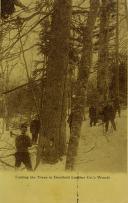
Cutting Trees in Deerfield Lumber Co.'s Woods
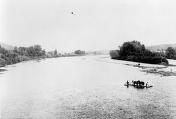
Log crew working above Sunderland Bridge

"Bad Jam of Logs" article in Greenfield's Gazette and Courier newspaper

"Annual Log Drive on the River"

"Burly Log Drivers Up River Start Biggest Drive Ever Seen"

Log Driving on the Connecticut River

Logging at the Oxbow on the Connecticut River near Holyoke, Mass.
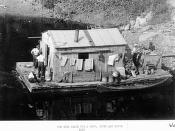
Log Drive Cook Shack on Connecticut River

"Turners Falls Boat Clubs to Insist on Open River"
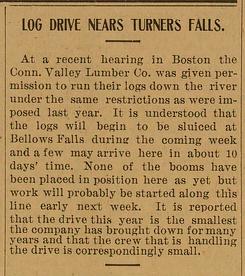
"Log Drive Nears Turners Falls" article in Greenfield's Gazette and Courier newspaper
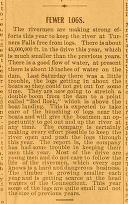
"Fewer Logs" article in Greenfield's Gazette and Courier newspaper
|
Summary and Objective
Students will understand that trees and rivers together played an important role in local history. They will learn about the uses of these natural resources by examining newspaper accounts and images of the log drives from the museum's collection. Students will use a graphic organizer to answer the 5Ws and H ( Who, What, When, Where, Why, and How ) of the news article to gain a better understanding of the story. Students will then create their own news articles about the log drives.
Teaching Plan
Step 1.
Pre-activity: The teacher has already covered what a natural resource is and the natural resources of the Northeast. Now the teacher leads a discussion of logging as a renewable resource still being done today in many areas of the world. Teacher could have images of logging operations today to display. Continue with the idea of examining early newspaper accounts of log drives to learn about the "old technology".
Step 2.
Students will go online to the digital collection at the American Centuries site and choose to read one of several newspaper articles on the Connecticut River log drives which have been selected for this actvity. Students may use the "close up" feature on the web site when reading. Students will be given a simple map of New England depicting the CT River with the northern source for logs and the towns mentioned in the articles highlighted.
Step 3.
Students will use a prepared graphic organizer of the 5 Ws and H ( Who, What, When, Where, Why, and How ) to cull the facts and better understand the story. The students should be familiar with use of graphic organizers from previous ELA lessons. Using the 5W's and H graphic organizer, students will act as reporters and create their own versions of the log drives.
Step 4.
Students will also examine images of the log drives and may use them to illustrate their news articles.
Step 5.
Students will share their newspaper reports with the class and display them.
Step 6.
An art extension to this lesson would be for the class to create a river from blue paper and make a model of a log drive using natural materials.
Step 7.
A literature extension to this lesson would be for the class to read the folk tales of Paul Bunyan.
Step 8.
An extension for older students might be to compare and contrast today's logging techniques with the past. This could lead to discussions of current environmental topics such as rainforest deforestation.
|




